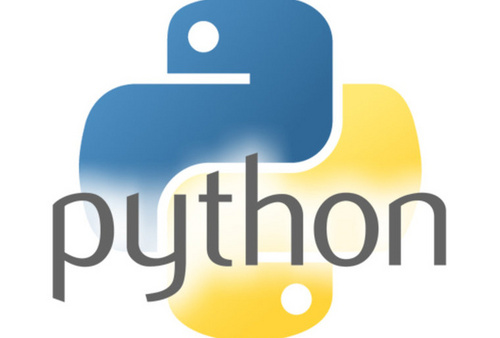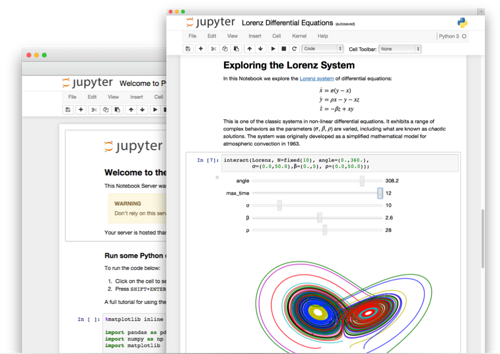Python语法速览与机器学习开发环境搭建
Python语法速览与机器学习开发环境搭建 从属于笔者的 程序猿的数据科学与机器学习实战手册 ,如果希望了解更多关于数据科学与机器学习知识体系结构,推荐阅读 2016:我的技术体系结构图:Web/ServerSideApplication/MachineLearning 、 面向程序猿的数据科学与机器学习知识体系及资料合集 。
Python

Python 是一门高阶、动态类型的多范式编程语言。人生苦短,请用Python,大量功能强大的语法糖的同时让很多时候Python代码看上去有点像伪代码。譬如我们用Python实现的简易的快排相较于Java会显得很短小精悍:
def quicksort(arr):
if len(arr) <= 1:
return arr
pivot = arr[len(arr) / 2]
left = [x for x in arr if x < pivot]
middle = [x for x in arr if x == pivot]
right = [x for x in arr if x > pivot]
return quicksort(left) + middle + quicksort(right)
print quicksort([3,6,8,10,1,2,1])
# Prints "[1, 1, 2, 3, 6, 8, 10]"
Python 版本
Python社区存在的最大的问题就是版本分裂,这也是笔者一直觉得有点鸡肋般的感觉,毕竟对于处女座而言实在是难受。目前Python社区中存在两个不同的主要版本:2.7与3.4。Python 3.0引入了很多不向后兼容的变化,因此很多遵循2.7版本的代码并不能适用于3.4版本。我们可以使用 python --version 命令来查看当前使用的版本。
常用习惯
| 模块 | 注意点 |
|---|---|
| 换行 | 反斜杠()继续上一行,Python文件以模块形式组织。Python程序语句不以分号结尾,而以换行符结尾。Python 使用硬回车来分割语句, 冒号和缩进来分割代码块。C++ 和 Java 使用分号来分割语句, 花括号来分割代码块。 |
| 注释 | a. 使用#符号标示注释; b. 在模块、类或者函数起始添加一个字符串起文档作用; c. 使用三引号标示注释。 print """ Usage: thingy [OPTIONS] -h Display this usage message -H hostname Hostname to connect to """ |
| 主流程 | Python 中没有子程序,只有函数, 所有的函数都有返回值,并且所有的函数都以 def 开始。 |
| 字符串 | Python中单引号与双引号的区别类似于PHP中,双引号中可以包括单引号。 |
| 数组 | Python中数组下标可以为负数,即从右端开始计量,-1即为最后一个数。Python不可以修改数组中值,字符串下标索引方式类似于MATLAB。 |
| 函数 | Python的函数可以嵌套定义 |
Installation:环境搭建
Conda
笔者推荐使用Anaconda作为环境搭建工具,并且推荐使用Python 3.5版本,可以在 这里 下载。如果是习惯使用Docker的小伙伴可以参考 anaconda-notebook
docker pull rothnic/anaconda-notebook docker run -p 8888:8888 -i -t rothnic/anaconda-notebook
安装完毕之后可以使用如下命令验证安装是否完毕:
conda --version
安装完毕之后我们就可以创建具体的开发环境了,主要是通过create命令来创建新的独立环境:
conda create --name snowflakes biopython
该命令会创建一个名为snowflakes并且安装了Biopython的环境,如果你需要切换到该开发环境,可以使用activate命令:
-
Linux, OS X:
source activate snowflakes -
Windows:
activate snowflakes
我们也可以在创建环境的时候指明是用python2还是python3:
conda create --name bunnies python=3 astroid babel
环境创建完毕之后,我们可以使用 info 命令查看所有环境:
conda info --envs
conda environments:
snowflakes * /home/username/miniconda/envs/snowflakes
bunnies /home/username/miniconda/envs/bunnies
root /home/username/miniconda
当我们切换到某个具体的环境后,可以安装依赖包了:
conda list # 列举当前环境中的所有依赖包 conda install nltk # 安装某个新的依赖
Jupyter Notebook

在Conda安装之后,Jupyter Notebook是默认安装好的,直接在工作目录下打开即可:
jupyter notebook
你可以参阅 Running the Notebook 获取更多命令细节。
基础数据类型
和其他主流语言一样,Python为我们提供了包括integer、float、boolean、strings等在内的很多基础类型。
数值类型
x = 3 print type(x) # Prints "<type 'int'>" print x # Prints "3" print x + 1 # Addition; prints "4" print x - 1 # Subtraction; prints "2" print x * 2 # Multiplication; prints "6" print x ** 2 # Exponentiation; prints "9" x += 1 print x # Prints "4" x *= 2 print x # Prints "8" y = 2.5 print type(y) # Prints "<type 'float'>" print y, y + 1, y * 2, y ** 2 # Prints "2.5 3.5 5.0 6.25"
不过需要注意的是,Python并没有 x++ 或者 x-- 这样的自增或者自减操作符。另外,Python内置的也提供了长整型与其他复杂数值类型的整合,可以参考 这里 。
布尔类型
Python提供了常见的逻辑操作符,不过需要注意的是Python中并没有使用 &&、|| 等,而是直接使用了英文单词。
t = True f = False print type(t) # Prints "<type 'bool'>" print t and f # Logical AND; prints "False" print t or f # Logical OR; prints "True" print not t # Logical NOT; prints "False" print t != f # Logical XOR; prints "True"
字符串
Python对于字符串的支持还是很好的,不过需要注意到 utf-8 编码问题。
hello = 'hello' # String literals can use single quotes world = "world" # or double quotes; it does not matter. print hello # Prints "hello" print len(hello) # String length; prints "5" hw = hello + ' ' + world # String concatenation print hw # prints "hello world" hw12 = '%s %s %d' % (hello, world, 12) # sprintf style string formatting print hw12 # prints "hello world 12"
Python中的字符串对象还包含了很多有用的方法,譬如:
s = "hello"
print s.capitalize() # Capitalize a string; prints "Hello"
print s.upper() # Convert a string to uppercase; prints "HELLO"
print s.rjust(7) # Right-justify a string, padding with spaces; prints " hello"
print s.center(7) # Center a string, padding with spaces; prints " hello "
print s.replace('l', '(ell)') # Replace all instances of one substring with another;
# prints "he(ell)(ell)o"
print ' world '.strip() # Strip leading and trailing whitespace; prints "world"
可以在 这里 中查看详细的方法列表。
复杂数据类型
列表
Python中的列表等价于数组,不过其能够动态扩展并且能够存放不同类型的数值。
xs = [3, 1, 2] # Create a list
print xs, xs[2] # Prints "[3, 1, 2] 2"
print xs[-1] # Negative indices count from the end of the list; prints "2"
xs[2] = 'foo' # Lists can contain elements of different types
print xs # Prints "[3, 1, 'foo']"
xs.append('bar') # Add a new element to the end of the list
print xs # Prints "[3, 1, 'foo', 'bar']"
x = xs.pop() # Remove and return the last element of the list
print x, xs # Prints "bar [3, 1, 'foo']"
同样你可以在 文档 中查看更多的细节。
切片
Python中对于数组的访问也相当人性化,通过简单的操作符即可以完成对于数组中子数组的截取。
nums = range(5) # range is a built-in function that creates a list of integers print nums # Prints "[0, 1, 2, 3, 4]" print nums[2:4] # Get a slice from index 2 to 4 (exclusive); prints "[2, 3]" print nums[2:] # Get a slice from index 2 to the end; prints "[2, 3, 4]" print nums[:2] # Get a slice from the start to index 2 (exclusive); prints "[0, 1]" print nums[:] # Get a slice of the whole list; prints ["0, 1, 2, 3, 4]" print nums[:-1] # Slice indices can be negative; prints ["0, 1, 2, 3]" nums[2:4] = [8, 9] # Assign a new sublist to a slice print nums # Prints "[0, 1, 8, 9, 4]"
遍历
你可以使用基本的 for 循环来遍历数组中的元素,就像下面介个样纸:
animals = ['cat', 'dog', 'monkey']
for animal in animals:
print animal
# Prints "cat", "dog", "monkey", each on its own line.
如果你在循环的同时也希望能够获取到当前元素下标,可以使用 enumerate 函数:
animals = ['cat', 'dog', 'monkey']
for idx, animal in enumerate(animals):
print '#%d: %s' % (idx + 1, animal)
# Prints "#1: cat", "#2: dog", "#3: monkey", each on its own line
变换
在编程中我们经常需要对数组进行变换,比较著名的我们可以使用 map、reduce、filter 这几个函数,而在Python中提供了非常方便的List Comprehension操作符。譬如我们需要对数组中元素进行依次平方操作
nums = [0, 1, 2, 3, 4]
squares = []
for x in nums:
squares.append(x ** 2)
print squares # Prints [0, 1, 4, 9, 16]
我们可以简写为如下方式:
nums = [0, 1, 2, 3, 4] squares = [x ** 2 for x in nums] print squares # Prints [0, 1, 4, 9, 16]
List Comprehensions也支持进行条件选择:
nums = [0, 1, 2, 3, 4] even_squares = [x ** 2 for x in nums if x % 2 == 0] print even_squares # Prints "[0, 4, 16]"
字典
Python中的字典类型即类似于Java中的Map或者JavaScript中的Object,也就是所谓的键值对类型,基本的使用方式为:
d = {'cat': 'cute', 'dog': 'furry'} # Create a new dictionary with some data
print d['cat'] # Get an entry from a dictionary; prints "cute"
print 'cat' in d # Check if a dictionary has a given key; prints "True"
d['fish'] = 'wet' # Set an entry in a dictionary
print d['fish'] # Prints "wet"
# print d['monkey'] # KeyError: 'monkey' not a key of d
print d.get('monkey', 'N/A') # Get an element with a default; prints "N/A"
print d.get('fish', 'N/A') # Get an element with a default; prints "wet"
del d['fish'] # Remove an element from a dictionary
print d.get('fish', 'N/A') # "fish" is no longer a key; prints "N/A"
更多的语法细节可以参考 这里 。
遍历
对于字典的遍历也非常简单:
d = {'person': 2, 'cat': 4, 'spider': 8}
for animal in d:
legs = d[animal]
print 'A %s has %d legs' % (animal, legs)
# Prints "A person has 2 legs", "A spider has 8 legs", "A cat has 4 legs"
如果你希望同时访问键和其对应的值,可以使用 iteritems 方法:
d = {'person': 2, 'cat': 4, 'spider': 8}
for animal, legs in d.iteritems():
print 'A %s has %d legs' % (animal, legs)
# Prints "A person has 2 legs", "A spider has 8 legs", "A cat has 4 legs"
变换
nums = [0, 1, 2, 3, 4]
even_num_to_square = {x: x ** 2 for x in nums if x % 2 == 0}
print even_num_to_square # Prints "{0: 0, 2: 4, 4: 16}"
Set
Set是一系列无序且唯一的元素的集合:
animals = {'cat', 'dog'}
print 'cat' in animals # Check if an element is in a set; prints "True"
print 'fish' in animals # prints "False"
animals.add('fish') # Add an element to a set
print 'fish' in animals # Prints "True"
print len(animals) # Number of elements in a set; prints "3"
animals.add('cat') # Adding an element that is already in the set does nothing
print len(animals) # Prints "3"
animals.remove('cat') # Remove an element from a set
print len(animals) # Prints "2"
更多语法细节可以参考 这里 。
遍历
集合遍历的语法和数组遍历很类似,不过因为集合本身是无序的,因此你不能够依赖于遍历的顺序来预测集合中元素的顺序:
animals = {'cat', 'dog', 'fish'}
for idx, animal in enumerate(animals):
print '#%d: %s' % (idx + 1, animal)
# Prints "#1: fish", "#2: dog", "#3: cat"
变换
from math import sqrt
nums = {int(sqrt(x)) for x in range(30)}
print nums # Prints "set([0, 1, 2, 3, 4, 5])"
Tuples
Python中的Tuple指不可变的有序元素集合,Tuple很类似于列表,不过区别在于Tuple可以做字典中的键类型,而列表则不可以。
d = {(x, x + 1): x for x in range(10)} # Create a dictionary with tuple keys
t = (5, 6) # Create a tuple
print type(t) # Prints "<type 'tuple'>"
print d[t] # Prints "5"
print d[(1, 2)] # Prints "1"
Function:函数
Python中的函数使用 def 关键字进行定义,譬如:
def sign(x):
if x > 0:
return 'positive'
elif x < 0:
return 'negative'
else:
return 'zero'
for x in [-1, 0, 1]:
print sign(x)
# Prints "negative", "zero", "positive"
同时,Python中的函数还支持可选参数:
def hello(name, loud=False):
if loud:
print 'HELLO, %s!' % name.upper()
else:
print 'Hello, %s' % name
hello('Bob') # Prints "Hello, Bob"
hello('Fred', loud=True) # Prints "HELLO, FRED!"
更多的语法细节可以参考 这里 。
Classes:类
Python中对于类的定义也很直接:
class Greeter(object):
# Constructor
def __init__(self, name):
self.name = name # Create an instance variable
# Instance method
def greet(self, loud=False):
if loud:
print 'HELLO, %s!' % self.name.upper()
else:
print 'Hello, %s' % self.name
g = Greeter('Fred') # Construct an instance of the Greeter class
g.greet() # Call an instance method; prints "Hello, Fred"
g.greet(loud=True) # Call an instance method; prints "HELLO, FRED!"
可以参考 这里 获取更多信息。
延伸阅读
-
Python Numpy Tutorial











![[HBLOG]公众号](https://www.liuhaihua.cn/img/qrcode_gzh.jpg)

